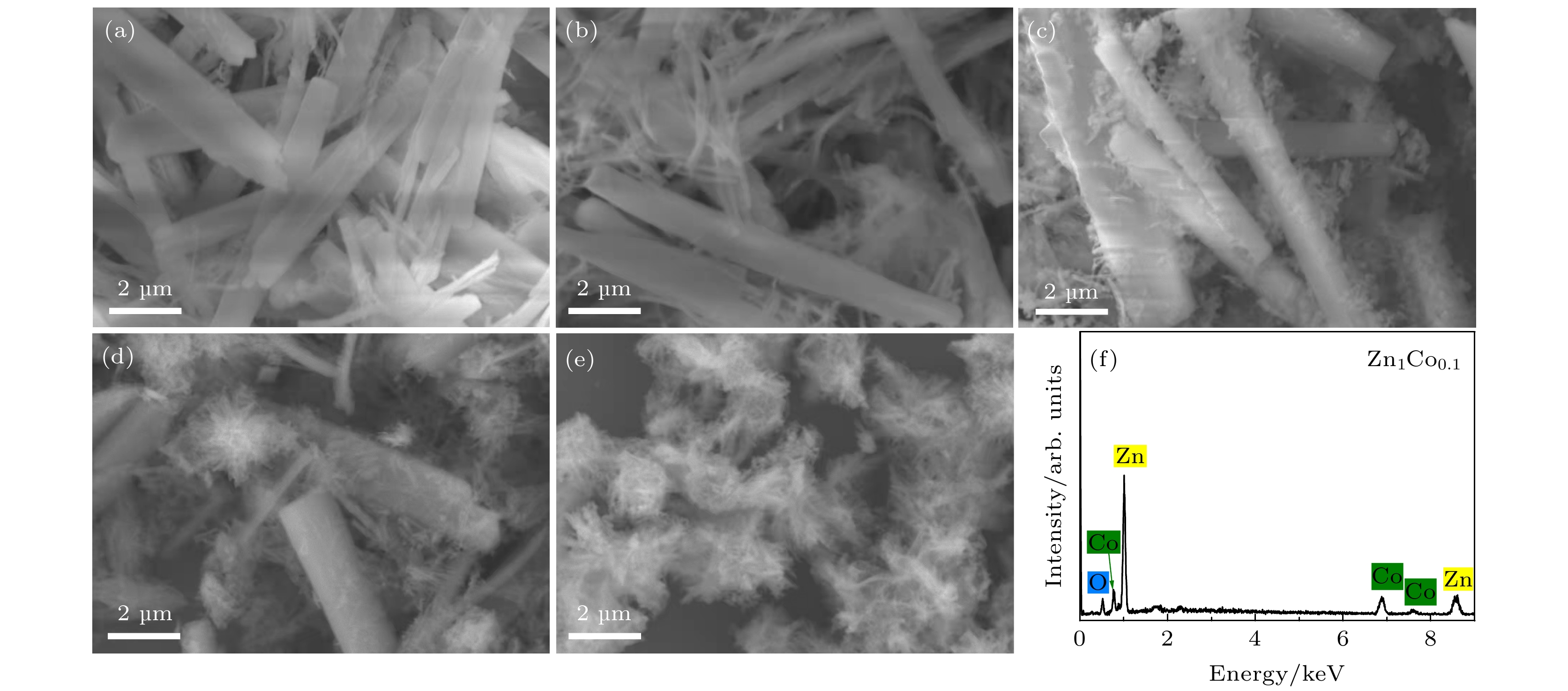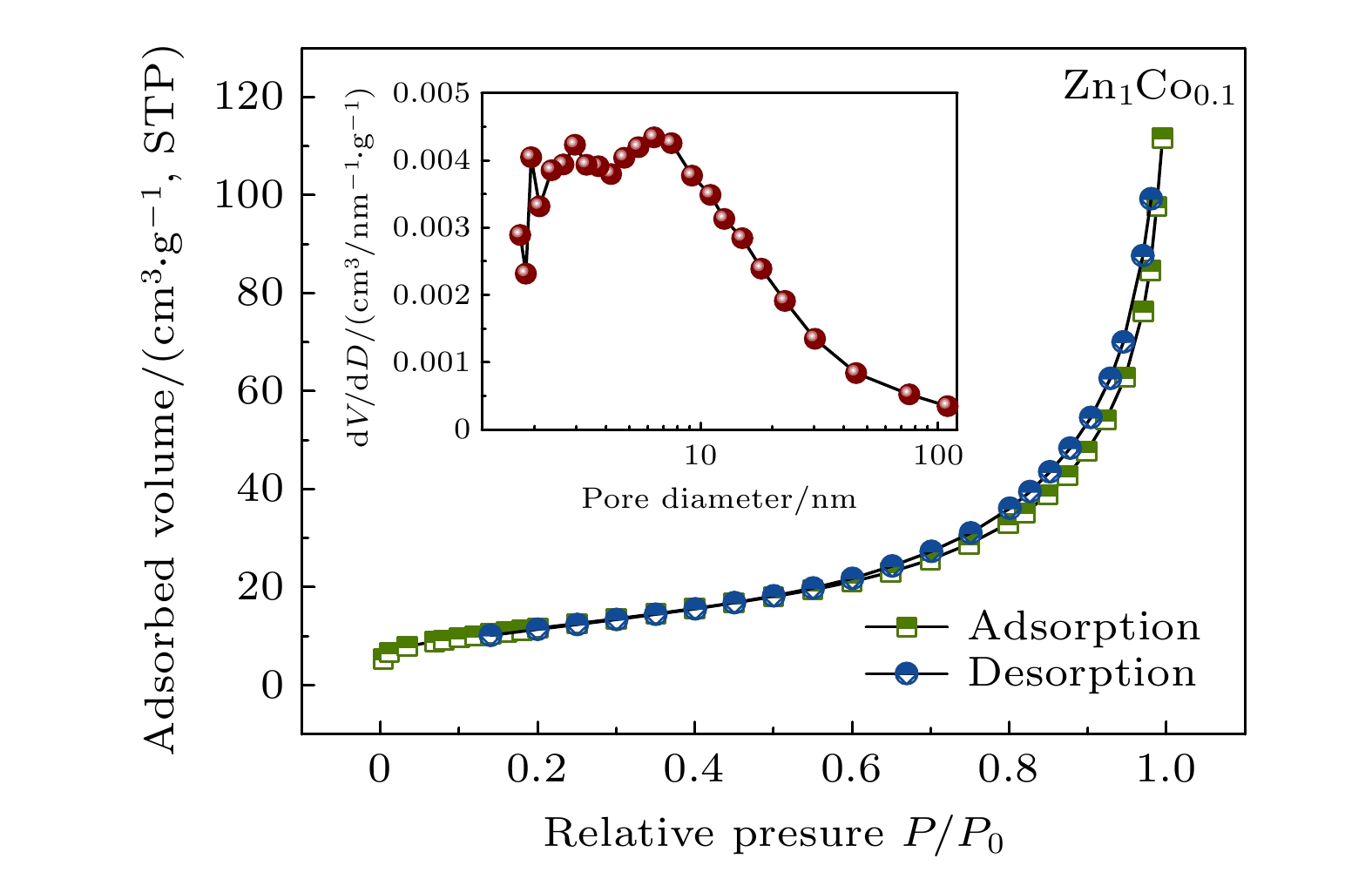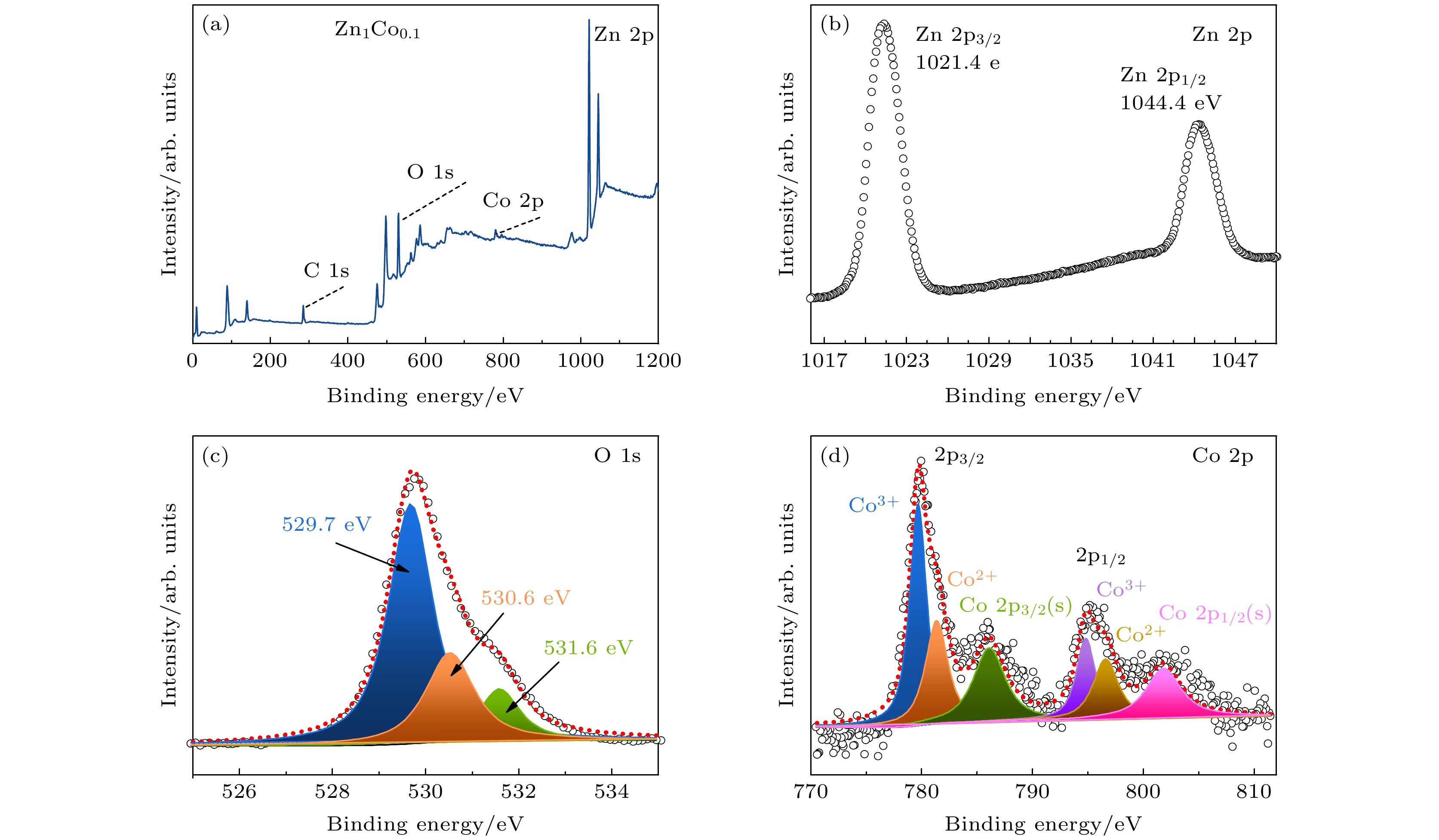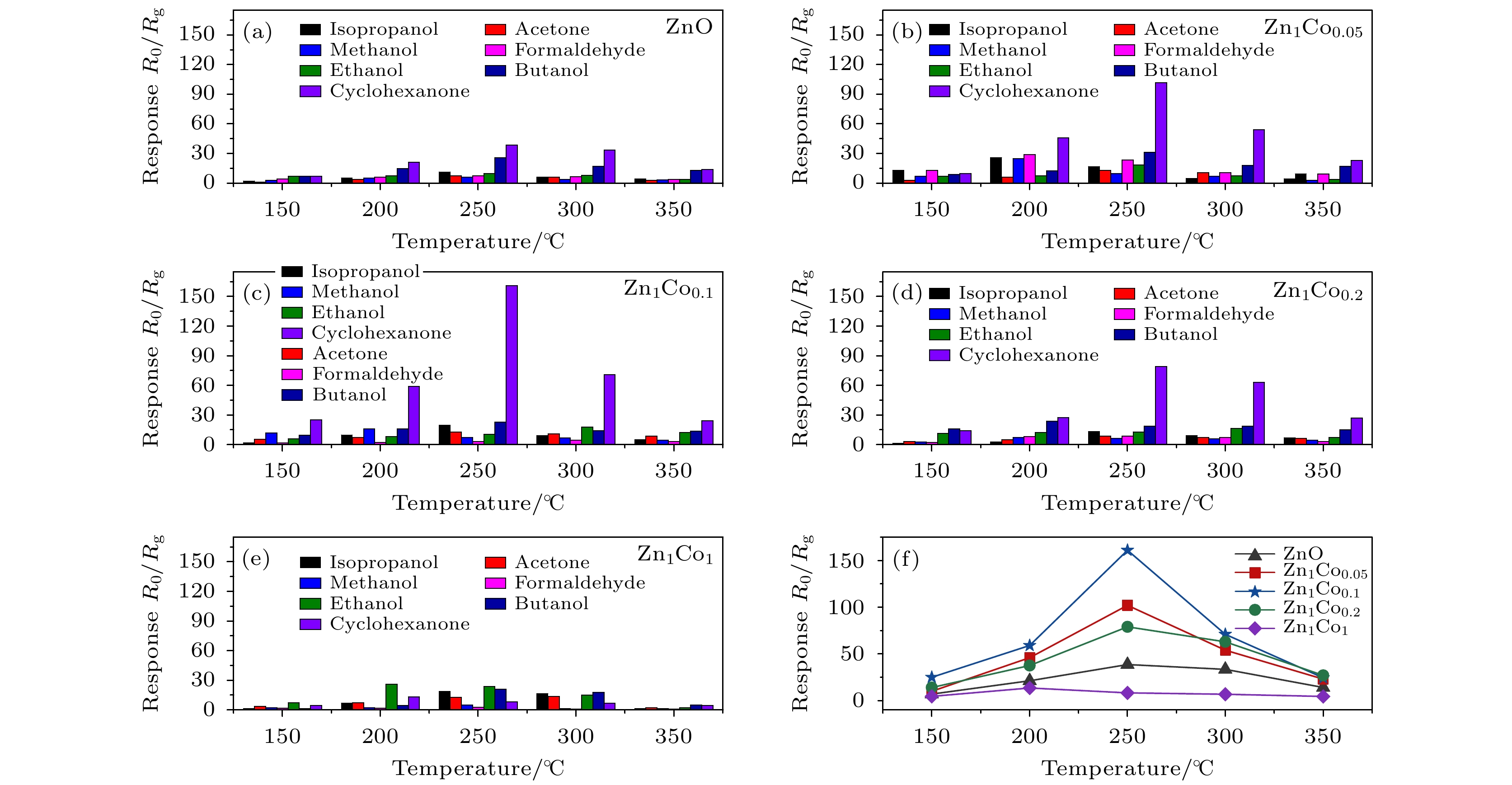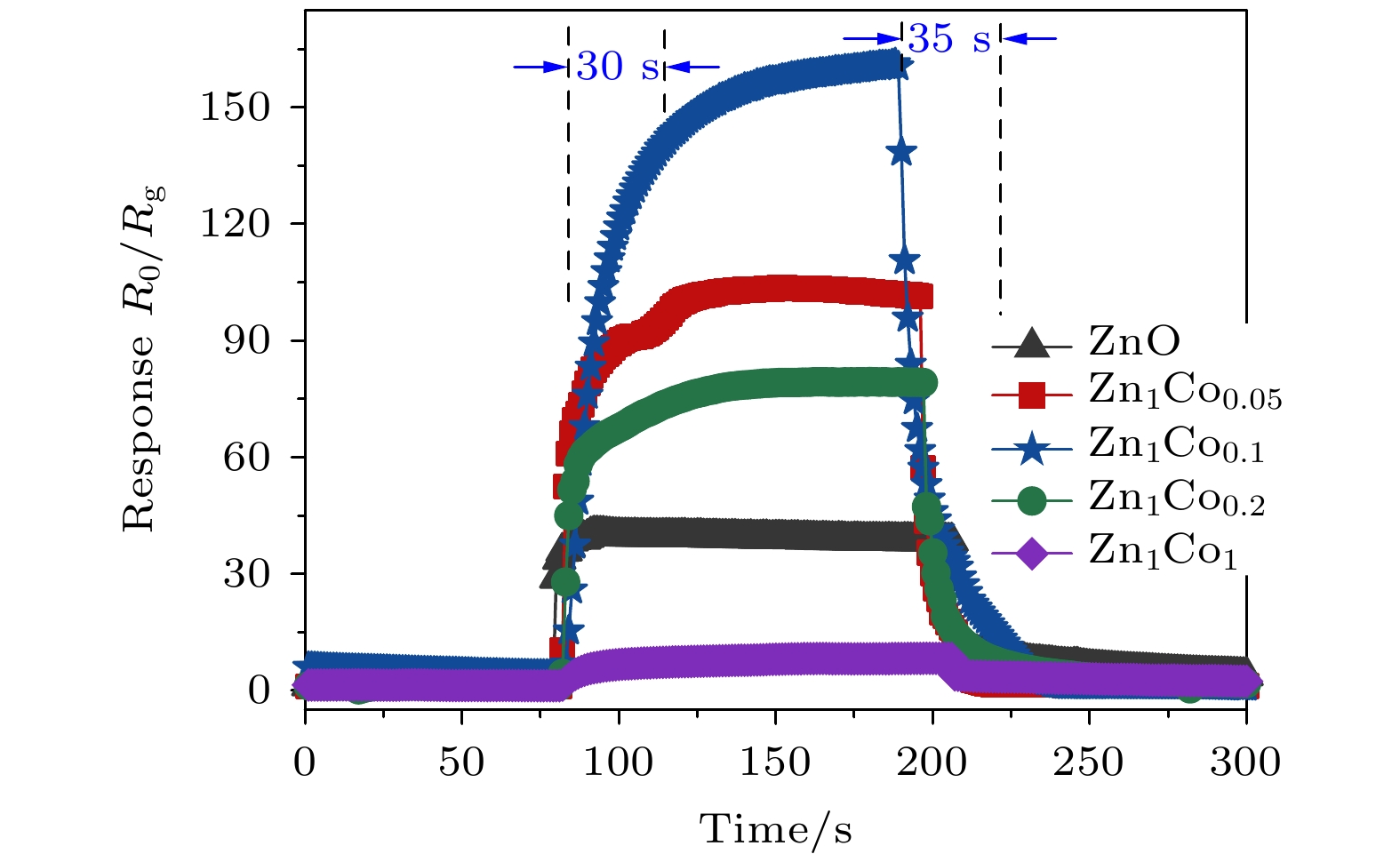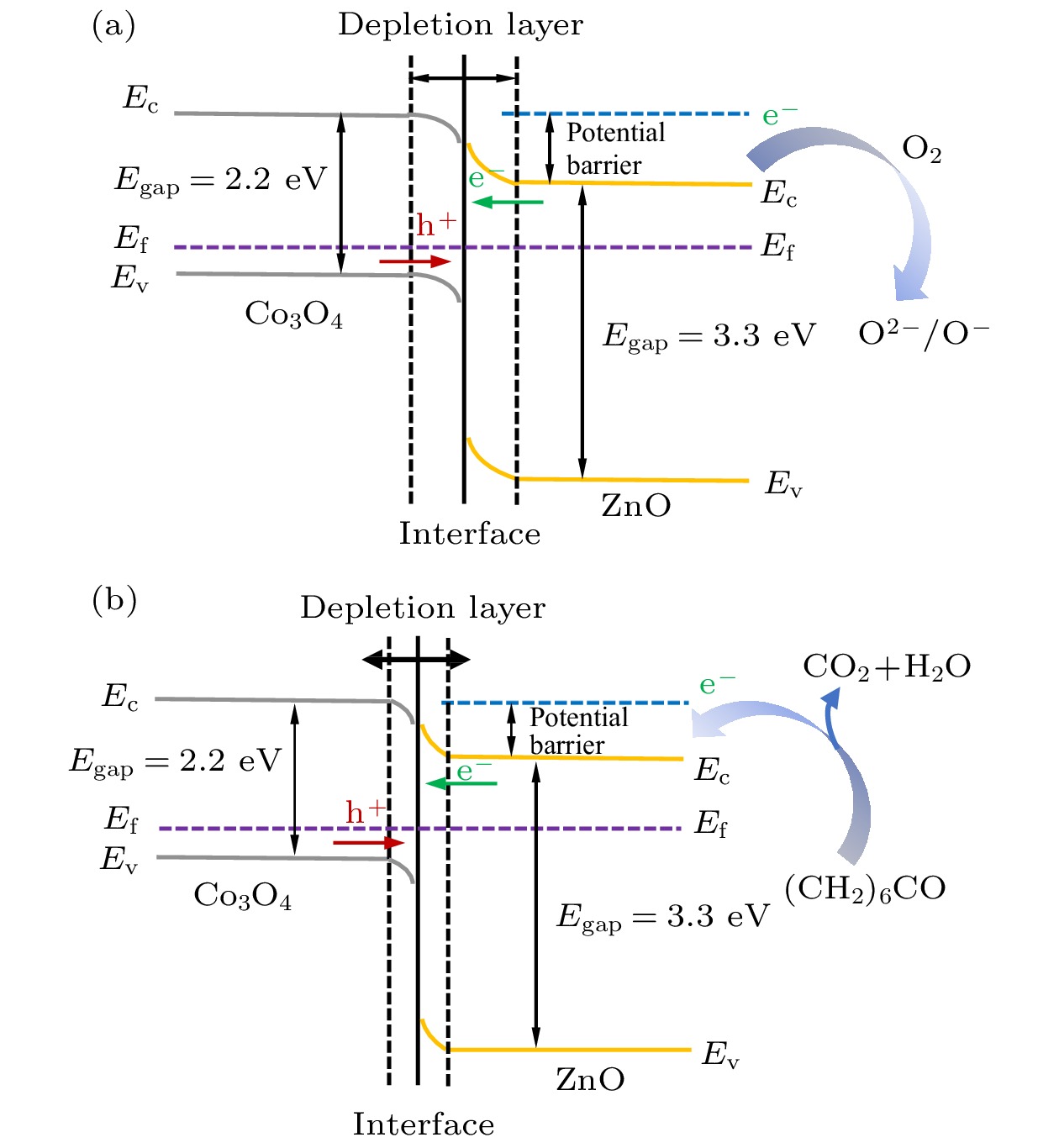-
采用溶剂热法制备了MOF衍生纯相ZnO和不同比例的ZnO/Co3O4复合微结构, 通过X射线衍射(XRD)、扫描电子显微镜(SEM)、X射线能量色散谱(EDS)、X射线光电子能谱(XPS)和表面积分析仪对所制备微结构的晶体结构、形貌和化学组成进行了分析. 基于上述材料制备气体传感器, 探究传感器对多种不同气体的响应特性. 实验结果表明: 大部分气体传感器在测试温度范围内对环己酮气体的响应值最高, 适量Co3O4复合可以有效提高ZnO微结构对环己酮的检测性能. ZnO/Co3O4复合微结构对环己酮的响应值随Co3O4含量的增加先升高后降低, 在最佳工作温度(250 ℃)下锌钴比例1∶0.1的ZnO/Co3O4传感器对体积分数为100 × 10–6环己酮气体的响应值可达161, 是相同条件下ZnO微结构的6.4倍, 且响应和恢复时间分别为30 s和35 s, 其优异的检测性能主要归因于ZnO和Co3O4之间形成的协同效应. 本文的工作在环己酮气体高性能检测方面有重要的应用价值.Metal-organic-framework(MOF)-derived pure ZnO and ZnO/Co3O4 composite microstructures with different ratios are prepared by the sol-vothermal method. The crystalline structure, morphology and chemical composition for each of the prepared micro-structures are analyzed by X-ray diffraction (XRD), scanning electron microscopy (SEM), X-ray energy dispersive spectroscopy (EDS), X-ray photoelectron spectroscope (XPS), and surface area analyzer respectively. The Gas sensors based on the as-prepared materials are fabricated and their performances of sensing various gases are investigated. The measurement results show that most of the gas sensors exhibit the highest responses to cyclohexanone gas within the test temperature range, and the composite with an appropriate amount of Co3O4 can obviously promote the cyclohexanoe-sensing property of ZnO microstructure. The response values of ZnO/Co3O4 composite microstructures to cyclohexanone first increase and then decrease with Co3O4 content increasing. The ZnO/Co3O4 composite microstructure sensor with a zinc-to-obalt ratio of 1∶0.1 shows that its value of response to cyclohexanone with a volume fraction of 100 × 10–6 at the optimum working temperature (250 ℃) can arrive at 161, which is 6.4 times higher than that of ZnO microstructure under the same condition. Besides, its response and recovery time are 30 s and 35 s, respectively. This excellent detection performance is attributed mainly to the synergy effect between ZnO and Co3O4. The work has an important application value in the high-performance detection of cyclohexanone.
-
Keywords:
- MOF-derived /
- ZnO/Co3O4 /
- gas sensors /
- cyclohexanone
[1] 陈小梅, 陈颖, 袁霞 2021 无机材料学报
 Google Scholar
Google Scholar
Chen X M, Chen Y, Yuan X 2021 J. Inorg. Mater.
 Google Scholar
Google Scholar
[2] 王志峰 2013 中国化工贸易 5 127
 Google Scholar
Google Scholar
Wang Z F 2013 China Chem. Trade 5 127
 Google Scholar
Google Scholar
[3] Li Z 2018 Chemosensors 6 34
 Google Scholar
Google Scholar
[4] Grazier K M, Swager T M 2013 Anal. Chem. 85 7154
 Google Scholar
Google Scholar
[5] Ong C N, Sia G L, Chia S E 1991 J. Anal. Toxicl. 15 13
 Google Scholar
Google Scholar
[6] Deelder R S, Hendricks P J H 1973 J. Chromatogr. A 83 343
 Google Scholar
Google Scholar
[7] Pijolat C, Pupier C, Sauvan M, Tournier G, Lalauze R 1999 Sens. Actuators B:Chem. 59 195
 Google Scholar
Google Scholar
[8] Gardon M, Guilemany J M 2013 J. Mater. Sci:Mater. Electron. 24 1410
 Google Scholar
Google Scholar
[9] Franke M E, Koplin T J, Simon U 2006 Small 2 36
 Google Scholar
Google Scholar
[10] Liu X, Cheng S T, Liu H, Hu S, Zhang D Q, Ning H S 2012 Sensors 12 9635
 Google Scholar
Google Scholar
[11] Katoch A, Abideen Z U, Kim J H, Kim S S 2016 Sens. Actuators B:Chem. 232 698
 Google Scholar
Google Scholar
[12] Yi G C, Wang C, Park W I 2005 Semicond. Sci. Tech. 20 S22
 Google Scholar
Google Scholar
[13] Meng D, Liu D Y, Wang G S, Shen B, San Y B, Si J P, Meng F L 2019 Appl. Surf. Sci. 463 348
 Google Scholar
Google Scholar
[14] Zhou T T, Zhang T 2021 Small Methods 5 2100515
 Google Scholar
Google Scholar
[15] Rothschild A, Komem Y 2004 J. Appl. Phys. 95 6374
 Google Scholar
Google Scholar
[16] Koo A, Yoo R, Woo S P, Lee H S, Lee W Y 2019 Sens. Actuators B: Chem. 280 109
 Google Scholar
Google Scholar
[17] Qi T, Yang X, Sun J 2019 Sens. Actuators B:Chem. 283 93
 Google Scholar
Google Scholar
[18] Lee C S, Dai Z F, Jeong S Y, Kwak C H, Kim B Y, Kim D H, Jang H W, Park J S, Lee J H 2016 Chem. Eur. J. 22 7102
 Google Scholar
Google Scholar
[19] Nie S, Dastan D, Li J, Zhou W D, Wu S S, Zhou Y W, Yin X T 2021 J. Phys. Chem. Solid 150 109864
 Google Scholar
Google Scholar
[20] Li B, Liu J Y, Liu Q, Chen R R, Zhang H S, Yu J, Song D L, Li J Q, Zhang M L, Wang J 2019 Appl. Surf. Sci. 475 700
 Google Scholar
Google Scholar
[21] Xiong Y, Liu W D, Qiao X R, Song X J, Wang S C, Zhang X L, Wang X Z, Tian J 2021 Sens. Actuators B: Chem. 346 130486
 Google Scholar
Google Scholar
[22] Bai S L, Guo J, Xiang X, Luo R X, Li D Q, Chen A F, Liu C C 2017 Sens. Actuators B: Chem. 245 359
 Google Scholar
Google Scholar
[23] Shingange K, Tshbalala Z P, Nteaeaborwa O M, Motaung D E, Mhlongo G H 2016 J. Colloid Interf. Sci. 479 127
 Google Scholar
Google Scholar
[24] Yun S, Lee J, Chung J, Lim S 2010 J. Phys. Chem. Solid 71 1724
 Google Scholar
Google Scholar
[25] Jing H Y, Song X D, Ren S Z, Shi Y T, An Y L, Yang Y, Feng M Q, Ma S B, Hao C 2016 Electrochim. Acta 213 252
 Google Scholar
Google Scholar
[26] Sakai G, Matsunaga N, Shimanoe K, Yamzoe N 2001 Sens. Actuators B 80 125
 Google Scholar
Google Scholar
[27] Suematsu K, Shin Y, Hua Z Q, Yoshida K, Yuasa M, Kida T, Shimanoe K 2014 ACS Appl. Mater. Interfaces 6 5319
 Google Scholar
Google Scholar
[28] Kida T, Kuroiwa T, Yuasa M, Shimanoe K, Yamazoe N 2008 Sens. Actuators B:Chem. 134 928
 Google Scholar
Google Scholar
[29] Ahn M W, Park K S, Heo J H, Kim D W, Choi K J, Park J G 2009 Sens. Actuators B:Chem. 138 168
 Google Scholar
Google Scholar
[30] Scott R W J, Yang S M, Chabanis G, Coombs N, Williams D E, Ozin G A 2001 Adv. Mater. 13 1468
 Google Scholar
Google Scholar
[31] Liu L, Li S C, Zhuang J, Wang L Y, Zhang J B, Li H Y, Liu Z, Han Y, Jiang X X, Zhang P 2011 Sens. Actuators B: Chem. 155 728
[32] Sahay P P, Nath R K 2008 Sens. Actuators B: Chem. 133 222
 Google Scholar
Google Scholar
[33] Zhou T T, Zhang T, Deng J N, Zhang R, Lou Z, Wang L L 2017 Sens. Actuators B: Chem. 242 369
 Google Scholar
Google Scholar
[34] Doan T L H, Kim J Y, Lee J H, Nguyen L H T, Dang Y T, Bui K B T, Pham A T T, Mirzaei A, Phan T B, Kim S S 2021 Sens. Actuators B: Chem. 348 130684
 Google Scholar
Google Scholar
[35] Kim H R, Haensch A, Kim II D, Barsan N, Weimar U, Lee J H 2011 Adv. Funct. Mater. 21 4456
 Google Scholar
Google Scholar
-
图 5 (a)—(e)ZnO和ZnO/Co3O4复合微结构的在不同温度下对7种体积分数为100 × 10–6不同气体的响应值, (f)在不同温度下对体积分数为100 × 10–6环己酮气体的响应曲线
Fig. 5. (a)–(e) Response vaules of ZnO and ZnO/Co3O4 composite microstructures to 100 × 10–6 (volume fraction) 7 kinds of different gases at different temperatures, and (f) response curves to 100 × 10–6 (volume fraction) cyclohexanone gas at different temperatures.
图 7 (a) ZnO和ZnO/Co3O4复合微结构在250 ℃时对不同浓度环己酮气体的响应恢复曲线, (b)传感器响应-环己酮浓度关系及(c)其对数形式关系
Fig. 7. (a) Response-recovery curves of ZnO and ZnO/Co3O4 composite microstructures to various concentration of cyclohexanone at 250 ℃; (b) the relationship curves of the responses-cyclohexanone concentrations and (c) relationship in logarithm form.
-
[1] 陈小梅, 陈颖, 袁霞 2021 无机材料学报
 Google Scholar
Google Scholar
Chen X M, Chen Y, Yuan X 2021 J. Inorg. Mater.
 Google Scholar
Google Scholar
[2] 王志峰 2013 中国化工贸易 5 127
 Google Scholar
Google Scholar
Wang Z F 2013 China Chem. Trade 5 127
 Google Scholar
Google Scholar
[3] Li Z 2018 Chemosensors 6 34
 Google Scholar
Google Scholar
[4] Grazier K M, Swager T M 2013 Anal. Chem. 85 7154
 Google Scholar
Google Scholar
[5] Ong C N, Sia G L, Chia S E 1991 J. Anal. Toxicl. 15 13
 Google Scholar
Google Scholar
[6] Deelder R S, Hendricks P J H 1973 J. Chromatogr. A 83 343
 Google Scholar
Google Scholar
[7] Pijolat C, Pupier C, Sauvan M, Tournier G, Lalauze R 1999 Sens. Actuators B:Chem. 59 195
 Google Scholar
Google Scholar
[8] Gardon M, Guilemany J M 2013 J. Mater. Sci:Mater. Electron. 24 1410
 Google Scholar
Google Scholar
[9] Franke M E, Koplin T J, Simon U 2006 Small 2 36
 Google Scholar
Google Scholar
[10] Liu X, Cheng S T, Liu H, Hu S, Zhang D Q, Ning H S 2012 Sensors 12 9635
 Google Scholar
Google Scholar
[11] Katoch A, Abideen Z U, Kim J H, Kim S S 2016 Sens. Actuators B:Chem. 232 698
 Google Scholar
Google Scholar
[12] Yi G C, Wang C, Park W I 2005 Semicond. Sci. Tech. 20 S22
 Google Scholar
Google Scholar
[13] Meng D, Liu D Y, Wang G S, Shen B, San Y B, Si J P, Meng F L 2019 Appl. Surf. Sci. 463 348
 Google Scholar
Google Scholar
[14] Zhou T T, Zhang T 2021 Small Methods 5 2100515
 Google Scholar
Google Scholar
[15] Rothschild A, Komem Y 2004 J. Appl. Phys. 95 6374
 Google Scholar
Google Scholar
[16] Koo A, Yoo R, Woo S P, Lee H S, Lee W Y 2019 Sens. Actuators B: Chem. 280 109
 Google Scholar
Google Scholar
[17] Qi T, Yang X, Sun J 2019 Sens. Actuators B:Chem. 283 93
 Google Scholar
Google Scholar
[18] Lee C S, Dai Z F, Jeong S Y, Kwak C H, Kim B Y, Kim D H, Jang H W, Park J S, Lee J H 2016 Chem. Eur. J. 22 7102
 Google Scholar
Google Scholar
[19] Nie S, Dastan D, Li J, Zhou W D, Wu S S, Zhou Y W, Yin X T 2021 J. Phys. Chem. Solid 150 109864
 Google Scholar
Google Scholar
[20] Li B, Liu J Y, Liu Q, Chen R R, Zhang H S, Yu J, Song D L, Li J Q, Zhang M L, Wang J 2019 Appl. Surf. Sci. 475 700
 Google Scholar
Google Scholar
[21] Xiong Y, Liu W D, Qiao X R, Song X J, Wang S C, Zhang X L, Wang X Z, Tian J 2021 Sens. Actuators B: Chem. 346 130486
 Google Scholar
Google Scholar
[22] Bai S L, Guo J, Xiang X, Luo R X, Li D Q, Chen A F, Liu C C 2017 Sens. Actuators B: Chem. 245 359
 Google Scholar
Google Scholar
[23] Shingange K, Tshbalala Z P, Nteaeaborwa O M, Motaung D E, Mhlongo G H 2016 J. Colloid Interf. Sci. 479 127
 Google Scholar
Google Scholar
[24] Yun S, Lee J, Chung J, Lim S 2010 J. Phys. Chem. Solid 71 1724
 Google Scholar
Google Scholar
[25] Jing H Y, Song X D, Ren S Z, Shi Y T, An Y L, Yang Y, Feng M Q, Ma S B, Hao C 2016 Electrochim. Acta 213 252
 Google Scholar
Google Scholar
[26] Sakai G, Matsunaga N, Shimanoe K, Yamzoe N 2001 Sens. Actuators B 80 125
 Google Scholar
Google Scholar
[27] Suematsu K, Shin Y, Hua Z Q, Yoshida K, Yuasa M, Kida T, Shimanoe K 2014 ACS Appl. Mater. Interfaces 6 5319
 Google Scholar
Google Scholar
[28] Kida T, Kuroiwa T, Yuasa M, Shimanoe K, Yamazoe N 2008 Sens. Actuators B:Chem. 134 928
 Google Scholar
Google Scholar
[29] Ahn M W, Park K S, Heo J H, Kim D W, Choi K J, Park J G 2009 Sens. Actuators B:Chem. 138 168
 Google Scholar
Google Scholar
[30] Scott R W J, Yang S M, Chabanis G, Coombs N, Williams D E, Ozin G A 2001 Adv. Mater. 13 1468
 Google Scholar
Google Scholar
[31] Liu L, Li S C, Zhuang J, Wang L Y, Zhang J B, Li H Y, Liu Z, Han Y, Jiang X X, Zhang P 2011 Sens. Actuators B: Chem. 155 728
[32] Sahay P P, Nath R K 2008 Sens. Actuators B: Chem. 133 222
 Google Scholar
Google Scholar
[33] Zhou T T, Zhang T, Deng J N, Zhang R, Lou Z, Wang L L 2017 Sens. Actuators B: Chem. 242 369
 Google Scholar
Google Scholar
[34] Doan T L H, Kim J Y, Lee J H, Nguyen L H T, Dang Y T, Bui K B T, Pham A T T, Mirzaei A, Phan T B, Kim S S 2021 Sens. Actuators B: Chem. 348 130684
 Google Scholar
Google Scholar
[35] Kim H R, Haensch A, Kim II D, Barsan N, Weimar U, Lee J H 2011 Adv. Funct. Mater. 21 4456
 Google Scholar
Google Scholar
计量
- 文章访问数: 11898
- PDF下载量: 156
- 被引次数: 0













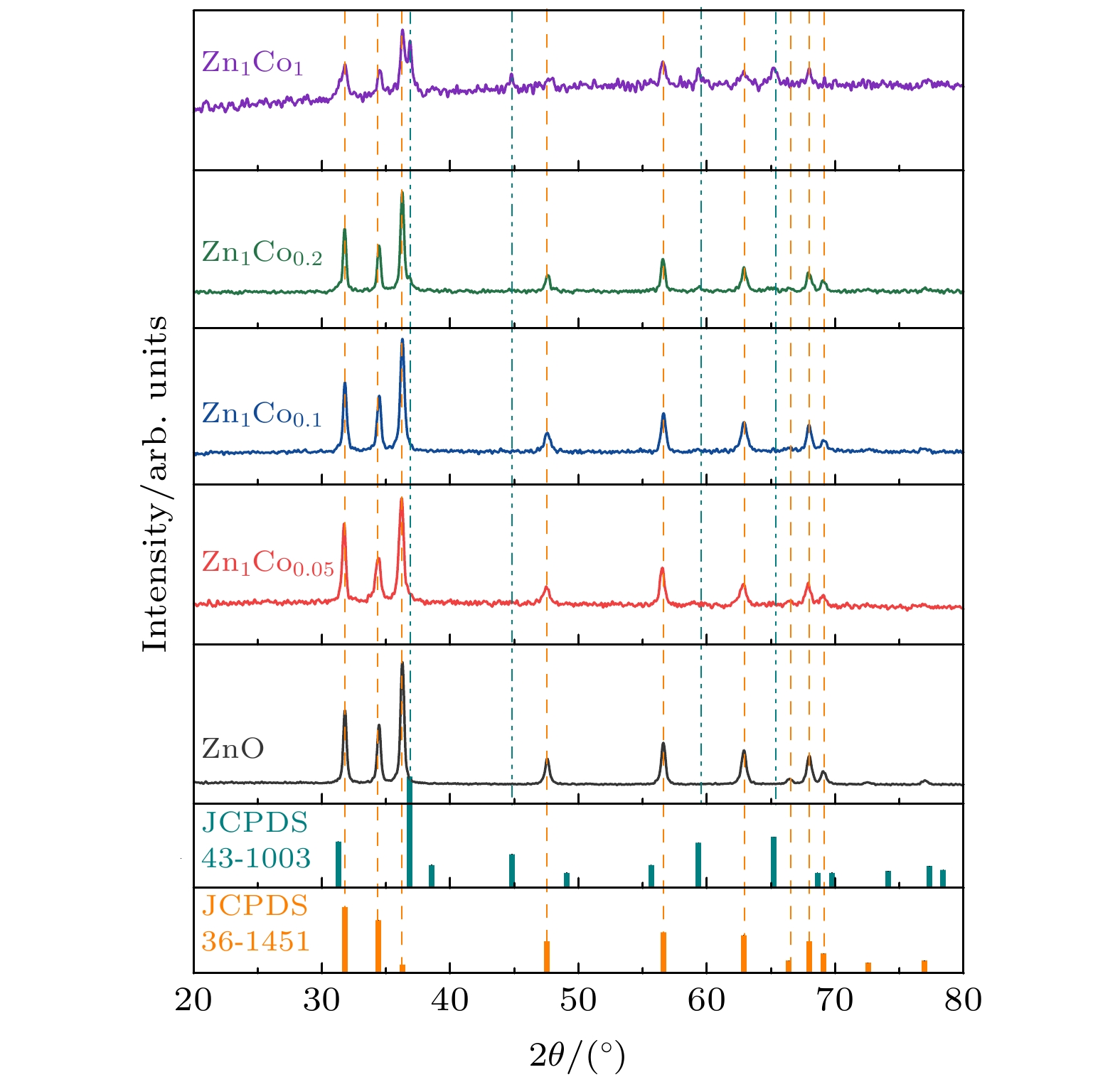
 下载:
下载:
